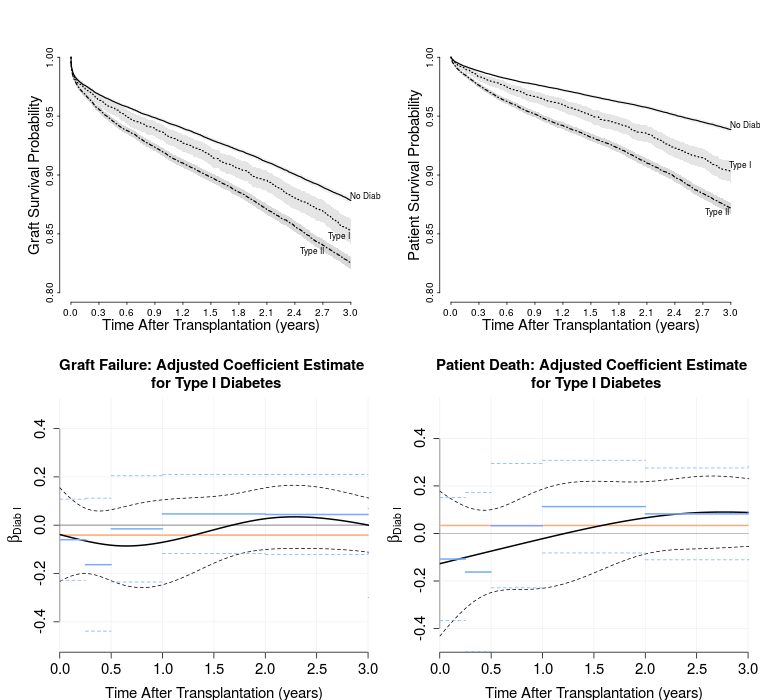Impact of Type of Recipient Diabetes on 1 and 3-Year Kidney Allograft and Patient Outcomes.
S. Kim, F. Wu, D. Cibrik, Y. Li, A. Naik.
University of Michigan, Ann Arbo
Meeting: 2017 American Transplant Congress
Abstract number: 352
Keywords: Graft survival, Kidney transplantation
Session Information
Session Name: Concurrent Session: Kidney: Cardiovascular and Metabolic
Session Type: Concurrent Session
Date: Monday, May 1, 2017
Session Time: 4:30pm-6:00pm
 Presentation Time: 4:30pm-4:42pm
Presentation Time: 4:30pm-4:42pm
Location: E451b
The pathophysiology of type 1 (T1DM) and type 2 (T2DM) diabetes is different and has been conjectured to impact transplantation outcomes differently over time especially given the higher comorbidities among T1DM. However current SRTR allograft and patient survival risk models do not use the type of diabetes (1 vs 2).
Methods: Our analysis used OPTN/UNOS for kidney transplants completed in 2008-2013. We conducted log rank test to examine the association of type of diabetes on rates of allograft and patient survival. To investigate whether the association is time dependent, we further used the Cox models with time-varying coefficients for diabetes type at various time points in the first 3 years after transplantation (with step function or natural cubic B-splines ), adjusting for multiple donor, recipient and transplantation characteristics. All survival models were stratified by the transplant centers.
Results: Of 92,414 transplant patients, 5.5% and 26.1% had T1DM and T2DM respectively. Patients with T1DM were younger on average than those with T2DM (mean age = 49.2 vs 58.6; p<0.001). PVD was more common among patients with T1DM (11.2% vs 9.8%; p=0.002). Duration of diabetes at transplantation was different between the groups (29.7 vs 19.0 years; p<0.001). The KM estimates of allograft survival differed significantly between the groups at 1-year post-transplantation (93.6% vs 91.9%; p<0.001) and at 3-year post-transplantation (85.2% vs 82.5%; p<0.001). The KM estimates for patient survival also differed significantly both at 1-year (96.4% vs 94.8%; p<0.001) and at 3-year post-transplantation (90.3% vs 87.1%; p<0.001). After adjusting for other risk factors, however, the effect of diabetes type (1 vs. 2) on both allograft and patient survival was no longer significant at any time point in the first three years after transplantation. Conclusion: Accounting for confounding effects, we did not observe statistically significant differences in 1 and 3-year allograft and patient outcomes by diabetes type at various time points in the first three years post transplantation. This may point to the validity of the current risk prediction model using diabetes but without defining type.
Conclusion: Accounting for confounding effects, we did not observe statistically significant differences in 1 and 3-year allograft and patient outcomes by diabetes type at various time points in the first three years post transplantation. This may point to the validity of the current risk prediction model using diabetes but without defining type.
CITATION INFORMATION: Kim S, Wu F, Cibrik D, Li Y, Naik A. Impact of Type of Recipient Diabetes on 1 and 3-Year Kidney Allograft and Patient Outcomes. Am J Transplant. 2017;17 (suppl 3).
To cite this abstract in AMA style:
Kim S, Wu F, Cibrik D, Li Y, Naik A. Impact of Type of Recipient Diabetes on 1 and 3-Year Kidney Allograft and Patient Outcomes. [abstract]. Am J Transplant. 2017; 17 (suppl 3). https://atcmeetingabstracts.com/abstract/impact-of-type-of-recipient-diabetes-on-1-and-3-year-kidney-allograft-and-patient-outcomes/. Accessed December 18, 2025.« Back to 2017 American Transplant Congress
